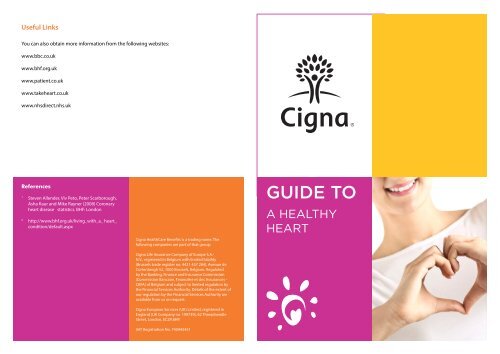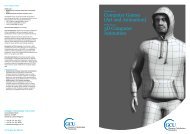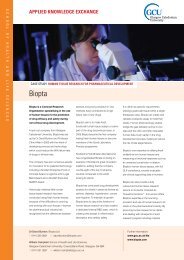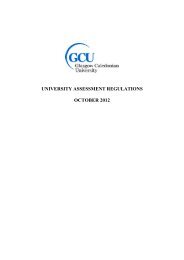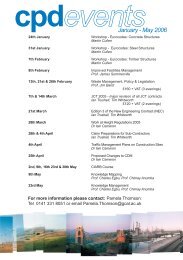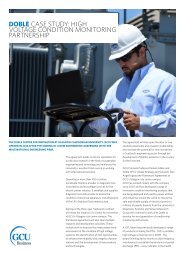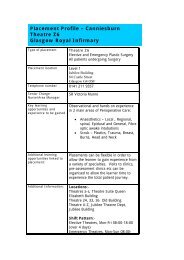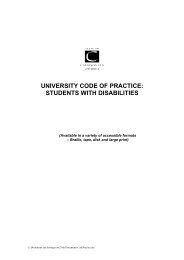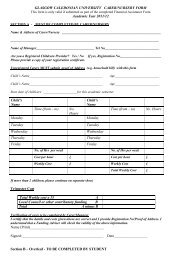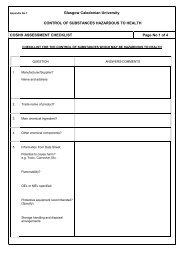Healthy Heart OH Leaflet
Healthy Heart OH Leaflet
Healthy Heart OH Leaflet
Create successful ePaper yourself
Turn your PDF publications into a flip-book with our unique Google optimized e-Paper software.
Useful Links<br />
You can also obtain more information from the following websites:<br />
www.bbc.co.uk<br />
www.bhf.org.uk<br />
www.patient.co.uk<br />
www.takeheart.co.uk<br />
www.nhsdirect.nhs.uk<br />
References<br />
1<br />
Steven Allender, Viv Peto, Peter Scarborough,<br />
Asha Kaur and Mike Rayner (2008) Coronary<br />
heart disease statistics. BHF: London<br />
2<br />
http://www.bhf.org.uk/living_with_a_ heart_<br />
condition/default.aspx<br />
Cigna HealthCare Benefits is a trading name. The<br />
following companies are part of that group:<br />
Cigna Life Insurance Company of Europe S.A.-<br />
N.V., registered in Belgium with limited liability<br />
(Brussels trade register no. 4421 437 284), Avenue de<br />
Cortenbergh 52, 1000 Brussels, Belgium. Regulated<br />
by the Banking, Finance and Insurance Commission<br />
(Commission Bancaire, Financière et des Assurances -<br />
CBFA) of Belgium and subject to limited regulation by<br />
the Financial Services Authority. Details of the extent of<br />
our regulation by the Financial Services Authority are<br />
available from us on request.<br />
Cigna European Services (UK) Limited, registered in<br />
England (UK Company no. 199739), 62 Threadneedle<br />
Street, London, EC2R 8HP.<br />
VAT Registration No. 740445451<br />
GUIDE TO<br />
A HEALTHY<br />
HEART
Guide to a healthy heart<br />
Introduction<br />
The heart is a highly complex organ – in fact, it’s the principal organ that keeps you alive. It is<br />
roughly the size of your fist and located in the middle of your chest, tilting slightly to the left.<br />
It’s basically a pump made out of muscle that has two chambers, two valves and a powerful<br />
electrical conduction system that keeps it beating and doing its job.<br />
When your body is at rest, the heart beats approximately 70 times a minute, pumping blood<br />
all around your body. When it’s working properly, you don’t give much thought to it. But<br />
because of its complex structure and its critical importance, when it functions poorly the<br />
consequences are usually serious and sometimes even life-threatening.<br />
How the heart works<br />
Your heart is divided into four hollow chambers. The upper two chambers are called atria and<br />
they are joined to two lower chambers called ventricles. These are the pumps of your heart.<br />
One-way valves between the<br />
chambers keep blood flowing<br />
through your heart in the<br />
right direction. As blood flows<br />
through a valve from one<br />
chamber into another the valve<br />
closes, preventing blood flowing<br />
backwards. As the valves snap<br />
shut, they make a thumping,<br />
‘heart beat’ noise.<br />
The heart wall is made up of<br />
a special muscle called the<br />
myocardium which needs a<br />
constant supply of blood. When<br />
this supply is reduced it can<br />
cause chest pain (angina) or<br />
when this supply is stopped for<br />
any period of time it can cause<br />
chest pain and death of a part of<br />
the myocardium (heart attack).<br />
Treatment<br />
Coronary heart disease cannot be cured<br />
but recent progress in the research and<br />
development of new medicines and<br />
significant improvements in surgical<br />
procedures have meant that the condition<br />
can now be managed more effectively.<br />
With the right treatment, the symptoms of<br />
coronary heart disease can be reduced and<br />
the functioning of the heart improved.<br />
Generally, treatments for heart disease aim<br />
to do one or more things:<br />
• Improve blood flow through the<br />
coronary arteries.<br />
• Reduce the build up of atherosclerosis.<br />
• Help the heart muscle to work better,<br />
allowing the heart to act more<br />
efficiently as a pump.<br />
• Change the electrical control of the<br />
heart, to influence its the rhythm. For<br />
example by slowing the heart when it<br />
beats too fast, or preventing abnormal<br />
rhythms such as atrial fibrillation.<br />
• Thin the blood to improve flow to stop<br />
clots from forming and prevent a heart<br />
attack.<br />
• Reduce the strain on the heart, for<br />
example by controlling blood pressure.<br />
There are a range of drugs doctors can use<br />
to treat heart disease. Many people will<br />
find that they’re advised to take several<br />
different medicines together, depending<br />
on the nature of their heart problem and<br />
whether they have risk factors such as high<br />
blood pressure. As with any medication,<br />
side-effects can be a problem. However, as<br />
there are usually different versions of any<br />
particular type of drug, your doctor may<br />
be able to prescribe an alternative if a drug<br />
doesn’t suit you.<br />
If you have any concerns about heart<br />
disease or want to find out more, please<br />
consult your GP.<br />
Quick fact<br />
Thanks to medical<br />
advancements there are<br />
many more people living<br />
with CHD than dying from<br />
it each year. 1<br />
1<br />
6
Guide to a healthy heart<br />
Eat a healthy diet<br />
High cholesterol levels in the blood<br />
increase the risk of developing CHD by<br />
causing the build up of fatty plaque in the<br />
artery walls that can harden and narrow<br />
the arteries. Nearly half of all deaths from<br />
CHD in the UK are thought to be caused by<br />
raised blood cholesterol.<br />
High cholesterol can be caused by a<br />
number of things such as smoking and<br />
physical inactivity. However, the key<br />
influence is diet and, in particular, the intake<br />
of saturated fats. Making a few simple<br />
changes to your diet can dramatically affect<br />
your cholesterol levels and heart health.<br />
The key to a healthy diet is to eat a wide<br />
variety of foods, in the right quantities, to<br />
match your body’s need for energy and<br />
nutrients. A third of the food you eat should<br />
be fruit and vegetables.<br />
Another third should be starchy foods such<br />
as bread, cereals, pasta, rice and potatoes<br />
– wholegrain and wholemeal varieties are<br />
best because of their fibre content.<br />
And the remaining third should include<br />
a moderate amount of dairy food, meat,<br />
fish and vegetarian alternatives and small<br />
amounts of foods containing fats and sugar.<br />
Quick fact<br />
On average a heart<br />
pumps 100,000 times<br />
every day pumping a<br />
total of 7,200 litres of<br />
blood over 19,000km! 2<br />
Make your diet a heart-healthy one with<br />
two small but significant steps:<br />
Fat<br />
Reduce the total amount you eat and<br />
avoid saturated and modified fats as<br />
much as possible. These fats lead to blood<br />
cholesterol levels that are unhealthy for<br />
your heart and arteries. Replace saturates<br />
with mono-unsaturated fats and choose<br />
foods containing omega-3 fatty acids -<br />
these types of fat are beneficial to your<br />
heart and arteries.<br />
Salt<br />
Our bodies do need small amounts of<br />
salt but eating too much is linked to high<br />
blood pressure, one of the risk factors for<br />
heart disease. Adults should have 6 grams<br />
of salt per day which equates to roughly<br />
a teaspoon. This is reached very quickly<br />
because there is so much salt in the foods<br />
we buy. In fact, a staggering 75% of the salt<br />
we eat comes from processed foods alone.<br />
Cutting down on your salt intake is easy.<br />
Try to avoid adding salt whilst cooking and<br />
then again at the dinner table and check<br />
food labels when you’re at the supermarket.<br />
<strong>Heart</strong> disease<br />
One of the most common diseases to affect the heart is coronary heart disease (CHD). The<br />
blood supply that takes oxygen and nutrients to your heart is provided by a network of blood<br />
vessels on the surface of your heart called coronary arteries. Coronary heart disease is the term<br />
that describes what happens when your heart’s blood supply is blocked or interrupted by a<br />
build up of fatty substances in these arteries.<br />
Over time, the walls of your arteries can become furred up with fatty deposits. This process<br />
is known as atherosclerosis and the fatty deposits are called atheroma. If your coronary<br />
arteries become narrow, due to a build up of atheroma, the blood supply to your heart will be<br />
restricted. This can cause angina. If a coronary artery becomes completely blocked, it can lead<br />
to myocardial infarction - commonly known as a heart attack.<br />
Angina<br />
Angina is the main symptom of CHD,<br />
caused by insufficient oxygen reaching the<br />
heart muscle because of reduced blood<br />
flow. It can be a mild, uncomfortable<br />
feeling that is similar to indigestion.<br />
However, a severe angina attack can cause a<br />
feeling of heaviness or tightness, usually in<br />
the centre of the chest, which may spread<br />
to the arms, neck, jaw, back or stomach.<br />
Angina is often triggered by physical<br />
activity or emotionally stressful situations.<br />
The symptoms usually pass within about<br />
10-15 minutes and can be relieved by<br />
resting or using a nitrate tablet or spray.<br />
<strong>Heart</strong> attack<br />
Unfortunately, for many people the first<br />
indication that something is wrong is a<br />
heart attack. This happens when the blood<br />
supply to a part of the heart muscle is<br />
completely interrupted or stops, usually<br />
when a blood clot forms in a diseased<br />
coronary artery that’s already become<br />
narrowed by atherosclerosis.<br />
Sometimes the pain of a heart attack can<br />
be mild and symptoms can be similar to<br />
that caused by indigestion. Some people<br />
can even have a heart attack without<br />
experiencing pain. However, in most cases<br />
the pain of a heart attack is severe. Unlike<br />
angina, the pain doesn’t subside when you<br />
rest and symptoms can’t be relieved using a<br />
nitrate tablet or spray.<br />
Other heart attack symptoms include<br />
sweating, light-headedness, nausea and<br />
breathlessness.<br />
5<br />
2
Guide to a healthy heart<br />
Causes of coronary<br />
heart disease<br />
As discussed, the most common cause<br />
of CHD is atherosclerosis - a build up<br />
of fatty deposits on the walls of the<br />
coronary arteries. Your risk of developing<br />
atherosclerosis is significantly increased if<br />
you:<br />
• smoke<br />
• eat an unhealthy diet<br />
• are overweight<br />
• do not take regular exercise<br />
• have high blood pressure<br />
• have a high blood cholesterol<br />
• have diabetes.<br />
Some people have a family history of the<br />
disease and are predisposed towards<br />
developing atherosclerosis due to inherited<br />
genetic factors.<br />
However, the good news is that, in all cases,<br />
by making the right lifestyle choices you<br />
can minimise the risk factors and reduce<br />
your chance of developing heart disease.<br />
Choose to have a<br />
healthy heart<br />
Don’t smoke<br />
Smoking is a major risk factor for<br />
developing atherosclerosis. By<br />
stopping smoking and avoiding smoky<br />
environments, you will dramatically reduce<br />
your risk of developing coronary heart<br />
disease.<br />
There are over 4000 chemicals in each<br />
cigarette. Many of these are poisonous and<br />
some are particularly harmful to your heart.<br />
Smokers younger than 50 are five times<br />
more likely than non-smokers to die of<br />
coronary heart disease and by quitting, you<br />
not only lower your risk of heart disease but<br />
also help reduce your risk of lung diseases<br />
such as cancer and chronic obstructive<br />
pulmonary disease (COPD).<br />
Despite the weight of evidence outlining<br />
the ill health effects of smoking, most<br />
smokers find it very difficult to give up.<br />
Don’t forget that nicotine is addictive<br />
and quitting smoking is often hard. The<br />
important thing is that you try and keep<br />
trying until you succeed.<br />
Be more physically active<br />
Prevention is always better than cure and<br />
being active is absolutely essential for a<br />
healthy heart. Even if you’ve already been<br />
diagnosed with heart disease, making<br />
lifestyle changes can help you live a longer,<br />
healthier and more enjoyable life.<br />
Making your heart beat faster, so that you’re<br />
left feeling slightly out of breath and warm,<br />
will boost your heart’s health. It can lower<br />
your blood pressure, blood cholesterol<br />
levels, weight and risk of developing<br />
diabetes.<br />
Becoming more active will also improve<br />
the ability of your body’s tissues to extract<br />
oxygen from your blood, help you maintain<br />
healthy levels of blood fats and speed up<br />
your metabolism.<br />
Aerobic or cardiovascular exercise is<br />
particularly important to prevent coronary<br />
heart disease. This includes any kind of<br />
activity that increases your breathing rate<br />
and gets you breathing more deeply.<br />
These activities include walking, running,<br />
swimming, dancing or any of the aerobic<br />
(cardiovascular) machines at the gym such<br />
as the rowing machine, treadmill, stepper<br />
or elliptical trainer. It will take less than you<br />
think.<br />
Only 30 minutes a day for 5 days of the<br />
week is required and you don’t have to do it<br />
all in one session. So, what are you waiting<br />
for?<br />
Quick fact<br />
<strong>Heart</strong> disease, stroke and<br />
other types of cardiovascular<br />
diseases are the biggest<br />
killer in the UK and a major<br />
cause of ill health. 1<br />
3<br />
4


